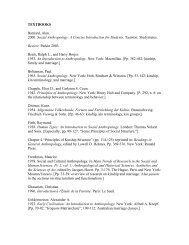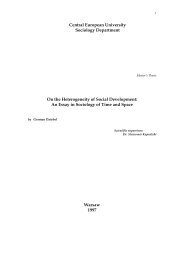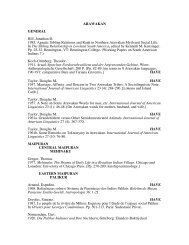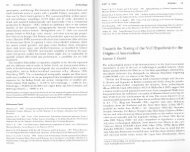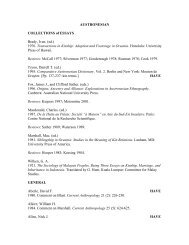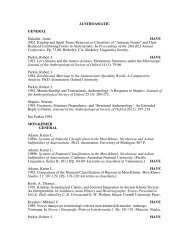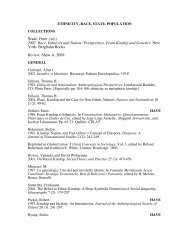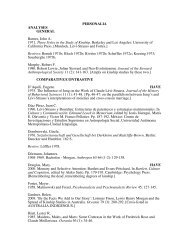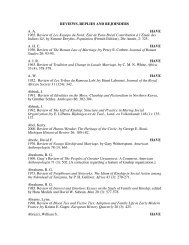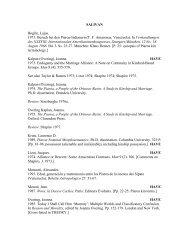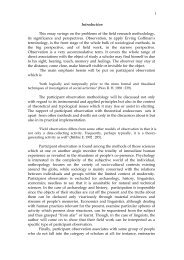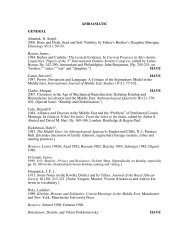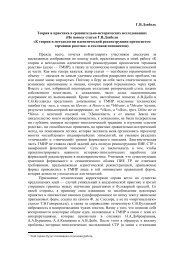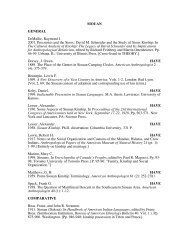INDO-EUROPEAN COLLECTIONS Firth, Raymond ... - Kinship Studies
INDO-EUROPEAN COLLECTIONS Firth, Raymond ... - Kinship Studies
INDO-EUROPEAN COLLECTIONS Firth, Raymond ... - Kinship Studies
You also want an ePaper? Increase the reach of your titles
YUMPU automatically turns print PDFs into web optimized ePapers that Google loves.
1894. Die Entstehung der Dehnstufe. Indogermanische Forschungen 3: 305-470. [P. 334:<br />
on IE *nepot ‘grandson.’] HAVE<br />
Streitberg, Wilhelm. HAVE<br />
1897. Die Indogermanische Sektion auf der vierundzwanzigsten versammlung deutscher<br />
Philologen und Schulmänner zu Dresden. 29. September – 2. Oktober 1897. Anzeiger für<br />
Indogermanische Sprach- und Altertumskunde 9 (1-2): 171-173. [On O. Schrader’s report<br />
on his research on IE kinship and social terms.]<br />
Streitberg, Wilhelm. HAVE<br />
1915. Die Bedeutung des Suffixes -ter-. Indogermanische Forschungen 35: 196-197.<br />
Sturtevant, Edgar H.<br />
1928a. Original h in Hittite and the Medio-Passive in r. Language 4 (3): 159-170. [Pp.<br />
162-163: the identification of Hitt huhhas ‘grandfather’ and hannas ‘grandmother’ as<br />
cognate with, respectively, Lat avus and anus.]<br />
Sturtevant, Edgar H. HAVE<br />
1928b. Review of The Vedic Declension of the Type vrkis, a Contribution to the Study of<br />
a Feminine Noun-Declension in Indo-European, by Ruth N. Albright. Language 4 (4):<br />
281-284. [Includes discussions of IE tanu- and devi- declensions with kin term examples<br />
and their transformation to i- and u-stems in Latin.]<br />
Sturtevant, Edgar H.<br />
1931. Changes of Quantity Caused by Indo-Hittite h. Language 7 (2): 115-124. [P. 119:<br />
Hit huhhas and Lat avus ‘grandfather’.]<br />
Sturtevant, Edgar H.<br />
1949. An Indo-European Word for ‘woman’. Language 25: 343-345.<br />
Sütterlin, L.<br />
1909. Der Schwund von idg. i und u. Indogermanische Forschungen 25: 51-76. [P. 70,<br />
no. 43, 45: IE *swekuro-, *sunu- and *snusos.] HAVE<br />
Szemerenyi, Oswald. HAVE<br />
1956a. How Far Can Conclusions about Cultural and Social Systems Be Drawn from<br />
Purely Linguistic Evidence in the IE Languages? In Proceedings of the 7 th International<br />
Congress of Linguists, London, 1-6 September 1952, edited by F. Norman. Pp. 515-517.<br />
London: The Congress. [Includes discussion of IE words for ‘sister’ and ‘father-in-law’,<br />
and an interpretation of the meaning of the swe-component.]<br />
Szemerényi, Oswald.<br />
1956b. Latin rēs and Indo-European Long-Diphthong Stem Nouns. Zeitschrift für<br />
Vergleichende Sprachforschung 73: 167-202. [Pp. 192-193, n. 1: on the IE term for<br />
‘woman, wife’.] HAVE<br />
Szemerényi, Oswald.<br />
1962. Principles of Etymological Research in the Indo-European Languages. In II.<br />
Fachtagung für Indogermanische und Allgemeine Sprachwissenschaft, Innsbruck, 10.-15.<br />
Oktober 1961. Pp. 175-212. Innsbruck: Sprachwissenschaftliche Institut der Leopold-<br />
Franzans-Universität. [Pp. 194-195: etymological analysis of an IE word for ‘boy, son’.]



